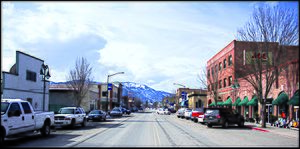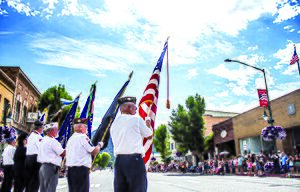Chewelah, Washington facts for kids
Quick facts for kids
Chewelah
|
|
|---|---|
| Chewelah, Washington | |

Main Avenue in Downtown Chewelah, 2018
|
|

Location of Chewelah, Washington
|
|
| Country | United States |
| State | Washington |
| County | Stevens |
| Area | |
| • Total | 2.95 sq mi (7.65 km2) |
| • Land | 2.95 sq mi (7.65 km2) |
| • Water | 0.00 sq mi (0.00 km2) |
| Elevation | 1,673 ft (510 m) |
| Population
(2020)
|
|
| • Total | 2,470 |
| • Density | 837.3/sq mi (322.9/km2) |
| Time zone | UTC-8 (Pacific (PST)) |
| • Summer (DST) | UTC-7 (PDT) |
| ZIP code |
99109
|
| Area code | 509 |
| FIPS code | 53-12140 |
| GNIS feature ID | 2409444 |
Chewelah (/tʃəˈwiːlə/ chə-WEE-lə) is a city in Stevens County, Washington, United States. It is located approximately 45 mi (72 km) northwest of Spokane. The population was 2,470 at the 2020 census.
Contents
History
The name of the town comes from a Kalispel word, sč̓ewíleʔ, meaning 'watersnake' or 'gartersnake'. Prior to colonization by European-Americans, Chewelah was home to a band of the Kalispel people. The band was known as the slet̓éw̓si, meaning "valley people". Originally, the area was called Fool's Prairie, after the indigenous Kalispel who left his own tribe because of a dispute. Chewelah and the rest of the Colville River Valley were part of the Colville Indian Reservation from April 9, 1872, when the reservation was created, until July 2, 1872, when a subsequent executive order reduced the size of the reservation. The Chewelah Band of Indians is currently part of the Spokane Tribe.
Thomas and Mary Brown moved to the Fool's Prairie in 1859. On May 8, 1872, Thomas Brown received authority to establish a post office called Chewelah. The name was first used in Stevens County Commissioner Journals on May 6, 1872. That post office disbanded on February 23, 1875. In 1879, the post office was reestablished with Major John Simms, Indian Agent, as postmaster. Chewelah was officially incorporated on January 26, 1903.
Chewelah is a town of firsts in Stevens County. It had the first Protestant Congregational Church in 1891, the first school in 1869, the Spokane Falls and Northern Railway arrived in 1889, a Catholic church was established in 1885, and the first county newspaper was founded in July 1885.
Initially, Chewelah was a pioneer settlement, being an agricultural center that can be traced back to the early 1870s and having prospectors working the adjacent countryside as early as 1842. The town was platted in 1884 and became known for being a rough and tumble mining town; the first lead and silver mines were established around 1886, and others followed in Embry and surrounding areas.
The town's newspaper, The Independent, was founded by William Hunter Brownlow (1860–1946) in 1903 and has been in publication ever since. The first issue came off the press on June 19, 1903, with the help of his four sons—Truman, Ralph, Arthur, and Alex—Brownlow. The family produced a weekly eight-page newspaper.
By 1905 the population had reached 650, and within a few years many prosperous copper, silver, lead, and some gold mines were flourishing in the area. The most successful ore mined in Chewelah was magnesite. By 1916 Chewelah's plant was said to be the largest producer of magnesite in the country, and at full production was the largest producer in the world, shipping some 700 tons daily. During the war, there were as many as 800 people working at the plant making high temperature-resistant refractory brick.
By 1920 Chewelah's population had grown to 1,600 people and continued to prosper until the late 1960s. In 1968, the magnesite plant closed down due to cheaper competition from Japan and changes in the steel industry. Despite this major change, Chewelah survived the transition from being a "one-company town", and today Chewelah has several thousand residents and displays a pleasant blend of the past and future. With its moderate climate, dry land, and irrigated farming, ranching and dairy farming continue to be mainstays. Chewelah's diversified economy also includes a ski area and golf course, among other industries.
In June 2019, the Chewelah Creative District became the second state-designated creative district in the state, following a similar designation for Edmonds.
Geography
According to the United States Census Bureau, the city has a total area of 2.98 square miles (7.72 km2), all land.
Climate
This climatic region is typified by large seasonal temperature differences, with warm to hot (and often humid) summers and cold (sometimes severely cold) winters. According to the Köppen Climate Classification system, Chewelah has a humid continental climate, abbreviated "Dfb" on climate maps.
| Climate data for Chewelah | |||||||||||||
|---|---|---|---|---|---|---|---|---|---|---|---|---|---|
| Month | Jan | Feb | Mar | Apr | May | Jun | Jul | Aug | Sep | Oct | Nov | Dec | Year |
| Record high °F (°C) | 57 (14) |
62 (17) |
75 (24) |
91 (33) |
100 (38) |
106 (41) |
107 (42) |
110 (43) |
104 (40) |
92 (33) |
69 (21) |
58 (14) |
110 (43) |
| Mean daily maximum °F (°C) | 33.9 (1.1) |
40.8 (4.9) |
49.2 (9.6) |
61.6 (16.4) |
69.4 (20.8) |
76.2 (24.6) |
86.6 (30.3) |
83.9 (28.8) |
75.5 (24.2) |
61.5 (16.4) |
45.5 (7.5) |
36.9 (2.7) |
60.1 (15.6) |
| Mean daily minimum °F (°C) | 19.8 (−6.8) |
23.6 (−4.7) |
27.8 (−2.3) |
33.9 (1.1) |
40.3 (4.6) |
45.7 (7.6) |
51.9 (11.1) |
50.7 (10.4) |
45.5 (7.5) |
36 (2) |
28.3 (−2.1) |
23.8 (−4.6) |
35.6 (2.0) |
| Record low °F (°C) | −38 (−39) |
−38 (−39) |
−12 (−24) |
12 (−11) |
16 (−9) |
26 (−3) |
31 (−1) |
28 (−2) |
12 (−11) |
2 (−17) |
−19 (−28) |
−33 (−36) |
−38 (−39) |
| Average precipitation inches (mm) | 2.3 (58) |
1.74 (44) |
1.83 (46) |
1.44 (37) |
1.75 (44) |
1.66 (42) |
0.82 (21) |
0.8 (20) |
1.06 (27) |
1.47 (37) |
2.4 (61) |
2.9 (74) |
20.17 (512) |
| Average snowfall inches (cm) | 14 (36) |
8.4 (21) |
3.6 (9.1) |
0.4 (1.0) |
0 (0) |
0 (0) |
0 (0) |
0 (0) |
0 (0) |
0.4 (1.0) |
3.7 (9.4) |
11.8 (30) |
42.4 (108) |
| Average precipitation days (≥ 0.01 inch) | 12 | 9 | 10 | 9 | 10 | 9 | 5 | 5 | 6 | 9 | 12 | 13 | 109 |
Demographics
| Historical population | |||
|---|---|---|---|
| Census | Pop. | %± | |
| 1910 | 823 | — | |
| 1920 | 1,288 | 56.5% | |
| 1930 | 1,315 | 2.1% | |
| 1940 | 1,565 | 19.0% | |
| 1950 | 1,683 | 7.5% | |
| 1960 | 1,525 | −9.4% | |
| 1970 | 1,365 | −10.5% | |
| 1980 | 1,888 | 38.3% | |
| 1990 | 1,945 | 3.0% | |
| 2000 | 2,186 | 12.4% | |
| 2010 | 2,607 | 19.3% | |
| 2020 | 2,470 | −5.3% | |
| U.S. Decennial Census 2015 Estimate |
|||
2010 census
As of the 2010 census, there were 2,607 people, 1,150 households, and 690 families residing in the city. The population density was 874.8 inhabitants per square mile (337.8/km2). There were 1,284 housing units at an average density of 430.9 per square mile (166.4/km2). The racial makeup of the city was 93.1% White, 0.2% African American, 1.7% Native American, 0.5% Asian, 0.7% from other races, and 3.7% from two or more races. Hispanic or Latino of any race were 2.8% of the population.
There were 1,150 households, of which 26.5% had children under the age of 18 living with them, 44.6% were married couples living together, 11.3% had a female householder with no husband present, 4.1% had a male householder with no wife present, and 40.0% were non-families. 35.6% of all households were made up of individuals, and 18.7% had someone living alone who was 65 years of age or older. The average household size was 2.22 and the average family size was 2.85.
The median age in the city was 45.2 years. 23% of residents were under the age of 18; 5.6% were between the ages of 18 and 24; 21.2% were from 25 to 44; 25.7% were from 45 to 64; and 24.6% were 65 years of age or older. The gender makeup of the city was 46.6% male and 53.4% female.
Arts and culture

Events
- Chataqua – formerly (1978–2020)
- James Dean Days (held on the first Saturday in August) – Car show and hot rod festival
Attractions
- Chewelah Museum
- Chewelah Golf and Country Club
- Chewelah Center for the Arts
- StageTime Theatre School
- Chewelah City Park
- Waitts Lake
- Copper Mine Hike
- Quartzite Mountain Trail, maintained by the Chewelah Boy Scout Troop 998
Education
- Chewelah School District
Media
- Newspaper – The Independent
- Radio – KCHW
Notable people
- David P. Jenkins – American Civil War cavalry officer and postbellum philanthropist
- John R. Monaghan – U.S. naval officer killed in action during the Second Samoan Civil War
- Allen Stone – soul musician
See also
 In Spanish: Chewelah (Washington) para niños
In Spanish: Chewelah (Washington) para niños



